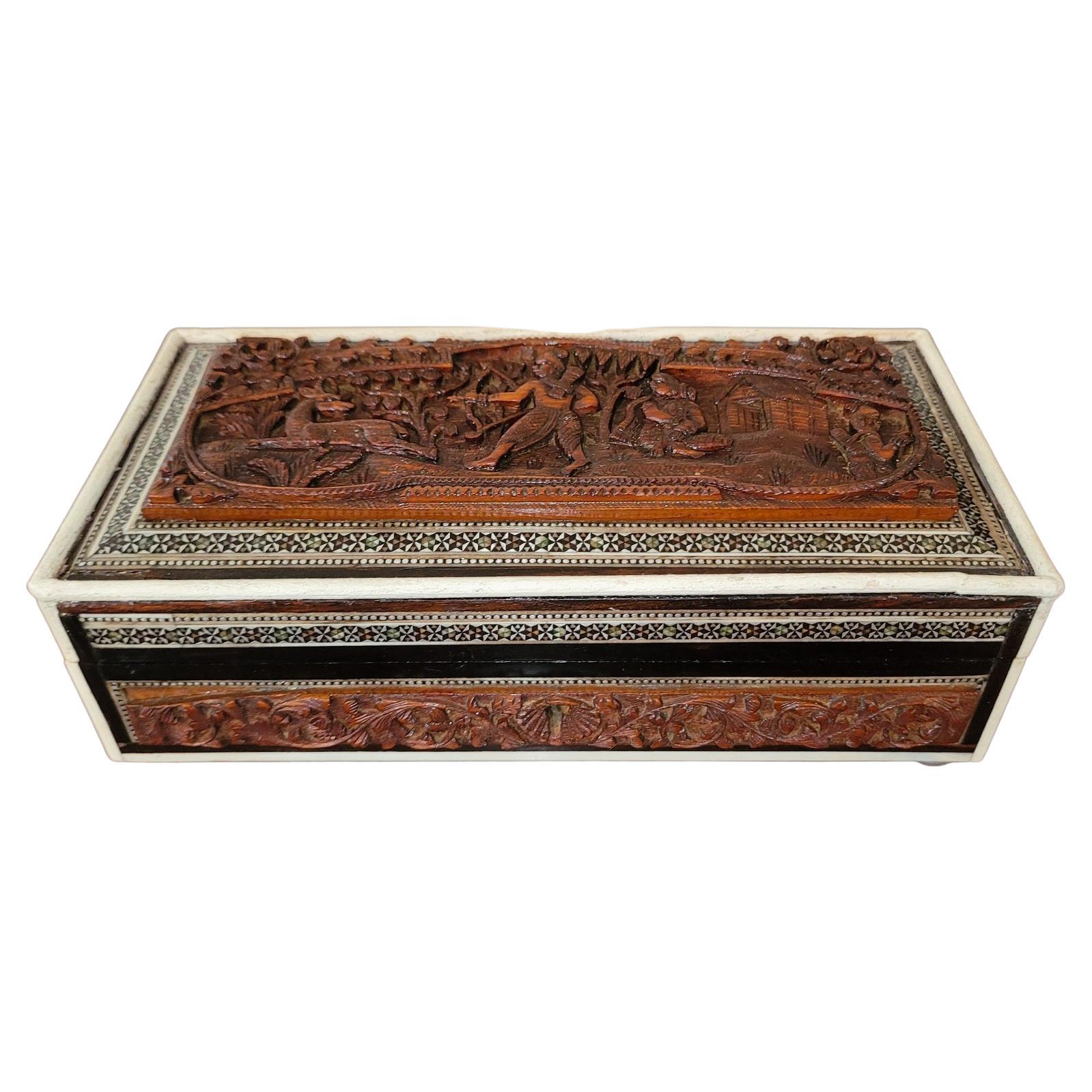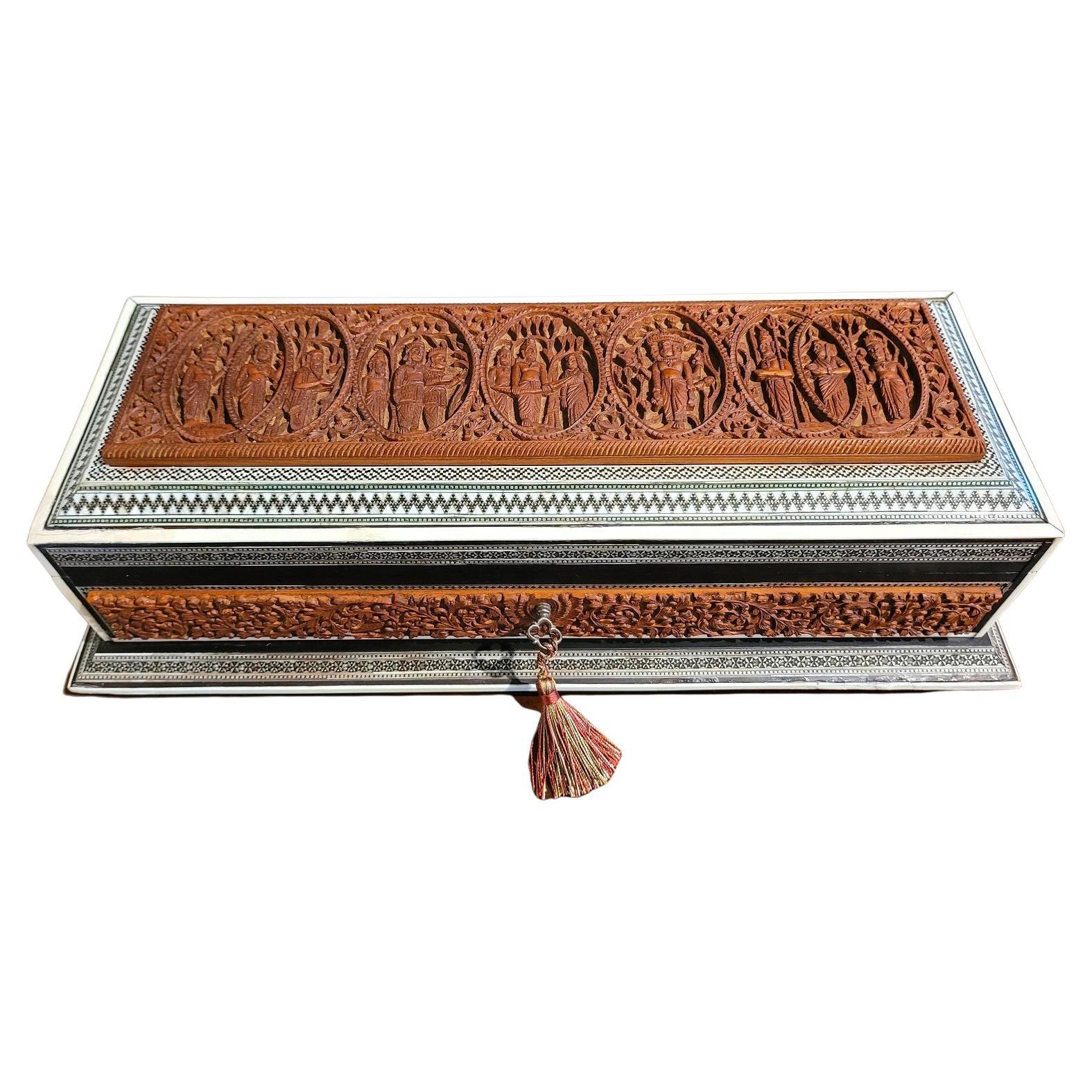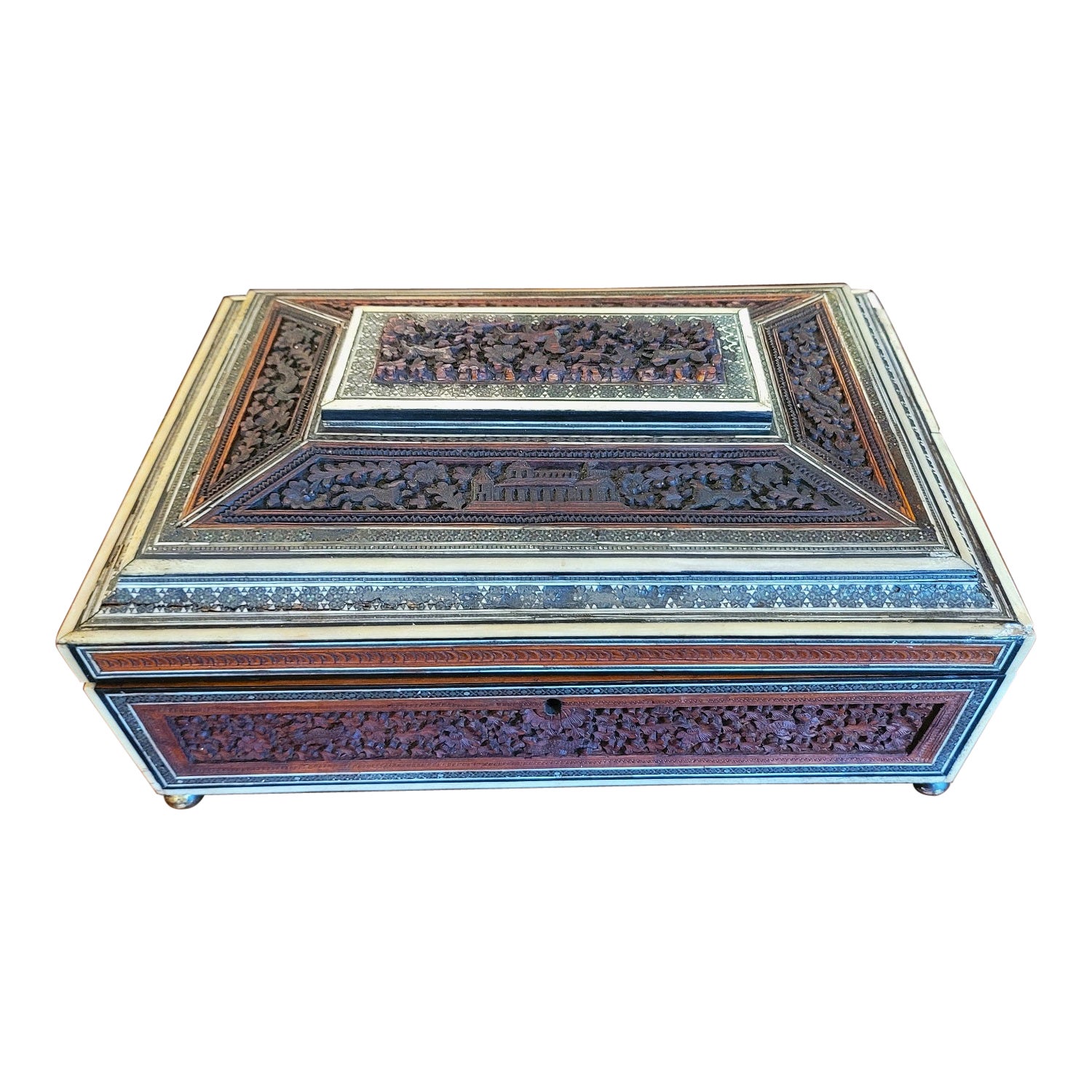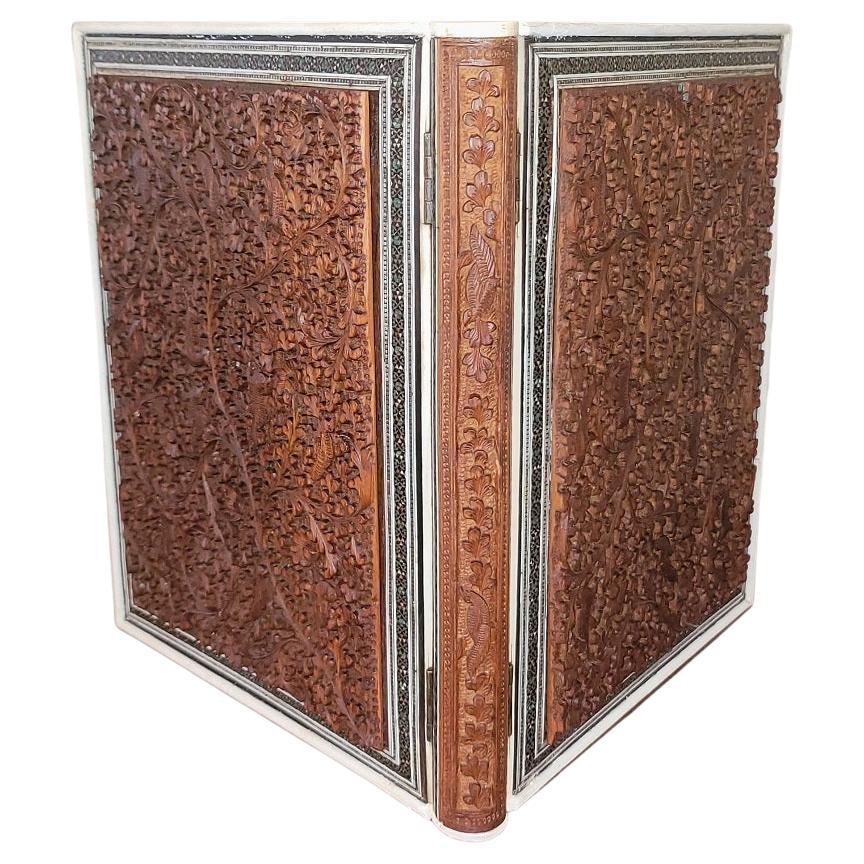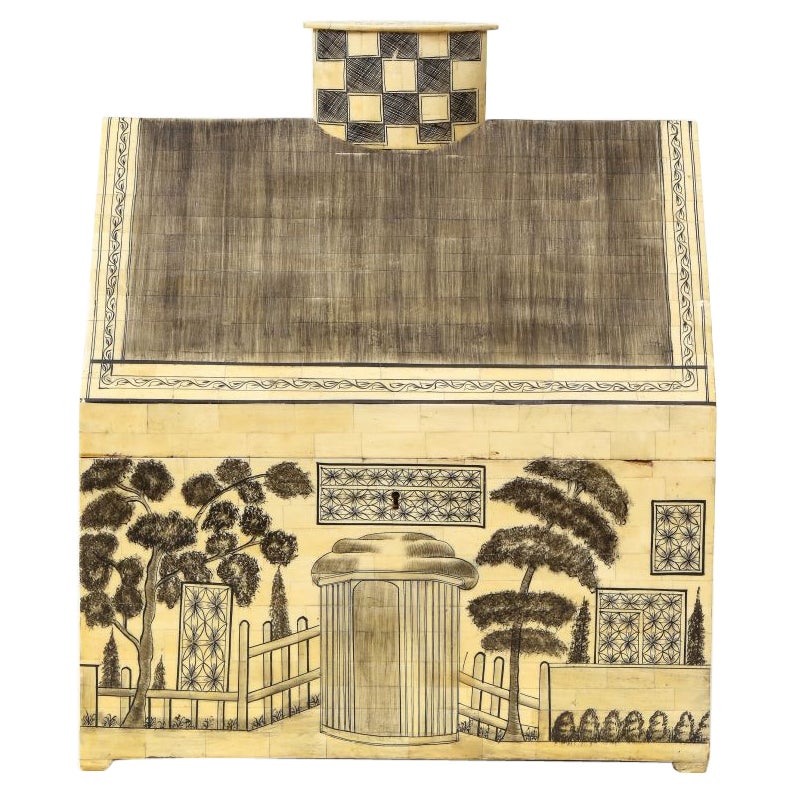Items Similar to Anglo-Indian Padouk Box
Want more images or videos?
Request additional images or videos from the seller
1 of 5
Anglo-Indian Padouk Box
About the Item
An Anglo-Indian brass-mounted padouk and ebony box, Ceylon, second half of the 18th century.
- Dimensions:Height: 5.5 in (13.97 cm)Width: 22.5 in (57.15 cm)Depth: 17.5 in (44.45 cm)
- Materials and Techniques:
- Period:
- Date of Manufacture:18th Century
- Condition:Wear consistent with age and use.
- Seller Location:London, GB
- Reference Number:1stDibs: LU943927735172
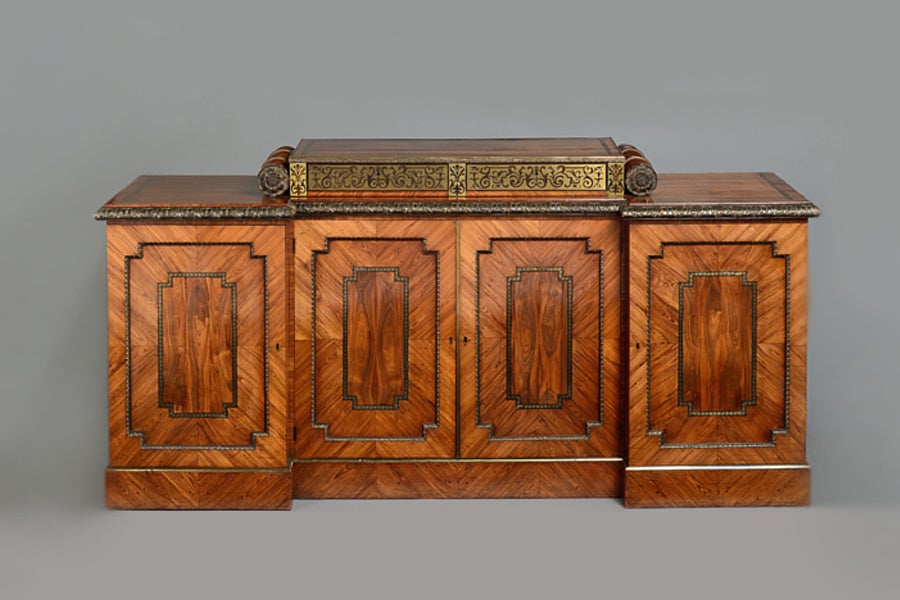
About the Seller
5.0
Vetted Seller
These experienced sellers undergo a comprehensive evaluation by our team of in-house experts.
1stDibs seller since 2012
22 sales on 1stDibs
Typical response time: 10 hours
Associations
LAPADA - The Association of Arts & Antiques Dealers
- ShippingRetrieving quote...Ships From: London, United Kingdom
- Return PolicyA return for this item may be initiated within 7 days of delivery.
More From This SellerView All
- Set of Four Anglo-Indian ArmchairsLocated in London, GBA FINE SET OF FOUR ANGLO-INDIAN SATINWOOD, EBONY AND EBONISED ARMCHAIRS, Circa 1830Category
Antique 19th Century Dining Room Chairs
MaterialsEbony, Satinwood
- Charles X Potpourri VaseLocated in London, GBA Charles X ormolu, Japanese porcelain and statuary marble potpourri. The porcelain 18th century, the mounts circa 1830. .Category
Antique 19th Century Vases
MaterialsOrmolu
- Bust of Sir Walter ScottLocated in London, GBWorkshop of Sir Francis Chantrey (1781-1841) A bust of Sir Walter Scott (1771-1832) Statuary marble Measures: 30in. (76cm) high.Category
Antique 19th Century Busts
MaterialsStatuary Marble
- Limestone StalactiteLocated in London, GBA limestone stalactite, South-Western France.Category
Antique 15th Century and Earlier Natural Specimens
- Elizabethan Revival Mantel Clock, circa 1840By Harvey & Co.Located in London, GBA fine early Victorian gilt-brass mantel clock by Harvey & Co in an Elizabethan Revival architectural style, circa 1840. The back plate inscribed ...Category
Antique 19th Century British Clocks
MaterialsBrass
- Joseph Gott Kneeling FigureLocated in London, GBJoseph Gott (1785-1860) 'A Hindu Woman Placing a Lamp on the Ganges’ Terracotta Measures: 13.5in. (34cm) high This terracotta figure is a finishe...Category
Antique 19th Century Figurative Sculptures
MaterialsTerracotta
You May Also Like
- 19C Anglo Indian Carved Padouk Wood and Sadeli Mosaic BoxLocated in Dallas, TXPRESENTING A LOVELY 19th century Anglo-Indian Carved Padouk Wood and Sadeli Mosaic Box, featuring a carving of a Hunt Scene. Made circa 1870 in Bombay, India during the Rule of th...Category
Antique Late 19th Century Indian Anglo-Indian Jewelry Boxes
MaterialsSilver, Pewter
- 19c Anglo Indian Highly Carved Padouk and Sandalwood Sarcophagus Sewing BoxLocated in Dallas, TXPRESENTING A VERY NICE 19C Anglo Indian Highly Carved Padouk and Sandalwood Sarcophagus Sewing Box. Made in Bombay, India circa 1890-1900. The box case/body is made of sandalwo...Category
Antique Late 19th Century Indian Anglo-Indian Decorative Boxes
MaterialsBone, Padouk, Sandalwood
- 19C Anglo Indian Highly Carved Padouk Sadeli Mosaic Scroll Box of Hindu GodsLocated in Dallas, TXPRESENTING AN ABSOLUTELY STUNNING AND EXCEPTIONAL 19C Anglo Indian Highly Carved Padouk Sadeli Mosaic Scroll Box of Hindu Gods from circa 1870-80. The box case is made from sandalwood with highly hand-carved padouk wood reliefs on all sides and banded and edged in fabulous ‘Sadeli Mosaic’, made from faux ivory/bone, ebony, silver, semi-precious green stone, etc., in various geometric patterns. The carved lid of this box is EXCEPTIONAL! It is HIGHLY HAND-CARVED and depicts 13 Hindu Gods: Vishnu, Shiva, Harihara, etc., in 9 oval shaped reliefs, surrounded by foliage etc. The sides and rear have highly carved foliage relief panels. The lid opens to reveal the original red velvet lining (also on the base) in SUPERB CONDITION throughout. The QUALITY of the ‘sadeli mosaic’ work is EXCEPTIONAL all over. It has its key and working lock. It sits on it’s 4 original brass turned ball feet. THIS IS A HIGH QUALITY & VERY RARE AND DESIRABLE BOX! SADELI MOSAIC: “Anglo Indian boxes were made in India for the English residents from the early part of the 18th century. They were brought back or sent back to England usually by the people who had commissioned them. From the beginning of the nineteenth century they were imported more commercially, although not in any significant numbers until the middle decades. They were very highly valued, especially the early ones, to the extent that the designs were copied on late 19th and early 20th century tins. The ancient art of Sadeli Mosaic is said to have been introduced from Shiraz in Persia via Sind to Bombay, a long time before the Anglo Indian boxes were made. It was a technique, which required a high degree of skill and patience. It was executed very lavishly, in that the frequent cuts wasted a great amount of the precious materials used. The workmanship was however more than commensurable to the value of the materials. Ivory, silver, pewter (or other metals), wood and horn were cut into faceted rods which were bound together to form geometric patterns. When the glue has set, the rods were sliced in transverse sections. This gave the maker a number of angled circular pieces in the original pattern. Several variations of patterns could be achieved by combining the materials in different ways. The ivory was sometimes dyed green to give an extra color. The mosaic pieces in a combination of patterns, often separated by ivory, ebony, horn or silver stringing were used to veneer sandalwood boxes. In the early boxes, which date from the turn of the 18th to the 19th century, there are large panels of mosaic covering tops and sides of boxes. It took incredible skill to cover such large areas without any shakes or wavering of the pattern. The corners and joins on these boxes are impeccably matched. The makers (reputed to be Persian) of Sadeli mosaic made in the first two decades of the 19th century displayed a total understanding of the qualities of the different materials they used. They combined substances, which can expand and contract according to atmospheric conditions with others, which are hard and unyielding. The result was a sharp definition of the lines and patterns, which made up the whole design. On the early boxes the designs look deceptively simple. The fact is, they emerged from a culture, which had mastered geometry and understood how to generate a pattern from a set number of points. The patterns are so harmoniously combined that their incredible complexity is not immediately apparent. The earliest Sadeli boxes...Category
Antique 19th Century Indian Anglo-Indian Decorative Boxes
MaterialsSilver
- 19C Anglo Indian Highly Carved Padouk Wood with Sadeli Mosaic Inlay Sewing BoxLocated in Dallas, TXPRESENTING A LOVELY 19C Anglo Indian Highly Carved Padouk Wood with Sadeli Mosaic Inlay Sewing Box. Made in Bombay, India, circa 1880. The box is made of sandalwood with highly carved raised padouk wood panels on all sides, depicting temple scenes, animals and foliage. The box is in a sarcophagus form. It is edged in bone (and we can tell it is bone and not ivory, from the color and evidence of capillaries, which are not found in ivory), and banded with Bombay Sadeli mosaic and ebony veneer. The lid opens to reveal a removable tray with various open compartments and lidded compartments. 5 lidded compartments, 1 unlidded compartment and 8 holders for thimbles, etc The tray lifts to reveal a blue velvet (original) lined section, for storing jewelry etc, with sections for collars etc. The inside of the lid has a removable mirror (the mirror is missing on this one but can easily be replaced). Behind the mirror is the original green velvet lining. It has its original brass carry handles on the sides and sits on 4 silvered button feet (of recent origin). Some repairs to the exterior and condition issues (priced accordingly), but still a LOVELY COLLECTIBLE box! These boxes were made by superb Indian craftsmen, specifically for sale to the ruling British elite. These types of boxes, carved padouk and sandalwood, (whilst beautiful and superbly crafted) were of a lesser quality, than the more profusely and intricately mosaic inlay, tortoiseshell and ivory boxes, made for the British ‘Upper Classes’ in the areas of Bombay and Vizagapatam. These type of boxes were much more affordable back in 1880 (and indeed today) and would probably have been bought by mid-level diplomats, civil servants or visitors. Sewing boxes (in general), were in EVERY Victorian home in Britain in the 19th century and like other boxes etc were ‘status symbols’ of your place in society! The more ornate the box, the more ‘Upper Class’ you were! SADELI MOSAIC: “Anglo Indian boxes were made in India for the English residents from the early part of the 18th century. They were brought back or sent back to England usually by the people who had commissioned them. From the beginning of the nineteenth century they were imported more commercially, although not in any significant numbers until the middle decades. They were very highly valued, especially the early ones, to the extent that the designs were copied on late 19th and early 20th century tins. The ancient art of Sadeli Mosaic is said to have been introduced from Shiraz in Persia via Sind to Bombay, a long time before the Anglo Indian boxes were made. It was a technique, which required a high degree of skill and patience. It was executed very lavishly, in that the frequent cuts wasted a great amount of the precious materials used. The workmanship was however more than commensurable to the value of the materials. Ivory, silver, pewter (or other metals), wood and Horn were cut into faceted rods which were bound together to form geometric patterns. When the glue has set, the rods were sliced in transverse sections. This gave the maker a number of angled circular pieces in the original pattern. Several variations of patterns could be achieved by combining the materials in different ways. The ivory was sometimes dyed green to give an extra color. The mosaic pieces in a combination of patterns, often separated by ivory, ebony, Horn or silver stringing were used to veneer sandalwood boxes. In the early boxes, which date from the turn of the 18th to the 19th century, there are large panels of mosaic covering tops and sides of boxes. It took incredible skill to cover such large areas without any shakes or wavering of the pattern. The corners and joins on these boxes are impeccably matched. The makers (reputed to be Persian) of Sadeli mosaic made in the first two decades of the 19th century displayed a total understanding of the qualities of the different materials they used. They combined substances, which can expand and contract according to atmospheric conditions with others, which are hard and unyielding. The result was a sharp definition of the lines and patterns, which made up the whole design. On the early boxes the designs look deceptively simple. The fact is, they emerged from a culture, which had mastered geometry and understood how to generate a pattern from a set number of points. The patterns are so harmoniously combined that their incredible complexity is not immediately apparent. The earliest Sadeli boxes...Category
Antique Late 19th Century Indian Anglo-Indian Decorative Boxes
MaterialsBone, Padouk, Sandalwood
- 19C Anglo Indian Highly Carved Padouk and Mosaic Folio CoverLocated in Dallas, TXPRESENTING A RARE AND DESIRABLE 19C Anglo Indian Highly Carved Padouk and Mosaic Folio Cover. This is a VERY RARE piece of Anglo-Indian and British Victorian Colonial history! ...Category
Antique Late 19th Century Indian Anglo Raj Decorative Boxes
MaterialsBone, Precious Stone, Sandalwood
- Anglo-Indian Style Penwork BoxLocated in New York, NYIn the form of a house; the hinged top opening to an open interior. In the spirit of early nineteenth century pinworm on ivory boxes that were highly collected in Regency England.Category
20th Century English Anglo-Indian Decorative Boxes
MaterialsIvory, Wood
Recently Viewed
View AllMore Ways To Browse
Indian Objects
Antique Anglo Indian
Anglo Indian Antique Furniture
Antique Anglo Indian Furniture
Anglo Indian Furniture Antique
Indian Brass
Indian Antique Brass
Antique Indian Brass
18th Century Indian
Antique Indian Box
Indian Ebony
Ceylon Furniture
Anglo Indian Boxes
Anglo Indian Box
Anglo Ebony
Anglo Indian Ebony
Ceylon Box
Indian Brass Box
